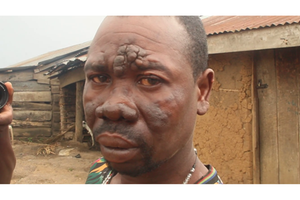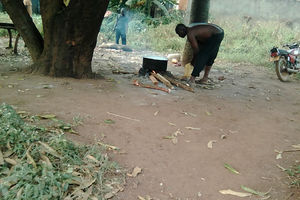
Donozio Balukuze, who was healed from leprosy, came to Buluba Hospital in 1977 and has never left. PHOTO | GODFREY MATSIKO
Sylvia Namugerwa, 35, is a symbol of resilience. Despite enduring stigma and self-hatred for 13 years, she remained unbroken. Although light-skinned, she bears black scars all over her body that were once leprosy nodules. Her legs are dark, and her feet are disfigured, with only a few toes remaining.
Originally from Mutukula District, Namugerwa now resides permanently at St. Francis Hospital Buluba in Buikwe District, which serves as a national referral centre for leprosy cases in Uganda.
Namugerwa fell ill in 2002, and it took her 10 years of visiting several hospitals to finally know what she was suffering from.
"It all started with a small swelling on my left leg, which I thought would go away on its own. However, it became very itchy and began to expand. Soon, other swellings appeared and also grew. When I left Mutukula, I had huge painful nodules all over my body," she says.
Namugerwa was admitted to Rakai General Hospital for six months, but she was eventually discharged because doctors could not diagnose her disease. Her family then took her to Masaka Regional Referral Hospital, where she remained bedridden for a year. By that time, the disease had progressed to other parts of her body.
“Doctors performed various tests but they could not figure out what the problem was. By the time I was referred to Mulago (National Referral Hospital) in 2015, I was so sick. The nodules were very hard and pieces were falling off my body. I had wounds all over my body and I was in so much pain. The doctors performed biopsies only to discover I did not have cancer,” she recalls.
A woman who was looking after a patient next to her advised Namugerwa’s brother to take her to a sheikh for prayers. After saying a Duwa prayer over her, the sheikh requested her brother to take her to St. Francis Hospital Nyenga as a last resort.
“I hated myself. My siblings were also tired. I had open wounds and I smelt bad. My fingers and toes were rotting and I was limping. The nodules on my eyes had burst and were leaking. My family members refused to escort me to Nyenga Hospital but gave me transport. I left home with only the clothes on my back. The taxi driver only allowed me into his taxi after I had paid a lot of money and instructed me to sit at the back,” she says.
At Nyenga, Namugerwa was referred to Buluba Hospital. She says, “The nurses kept asking why I had taken so long to come for treatment. I did not yet know what I was suffering from. I spent four years in Buluba, receiving treatment. They kept cutting off pieces of my body to prevent the disease from spreading further until I was eventually cured.”
Even though she is completely healed, Namugerwa cannot see without the special glasses she was given at the hospital. She cannot go near fire or anything hot, either.
“When the nodules on my eyes burst, they damaged my eyesight. Some parts of my legs and arms are numb. I am not allowed to cook because if I accidentally burn myself, I will not feel it. If I get a wound today, it will heal after one year because some of my nerves are dead. Doctors say if I had come to Buluba much earlier, I would have been healed without losing parts of my body,” she narrates.
Because of the heavy medication she was on for four years, Namugerwa says she developed ulcers and high blood pressure.
Incidence of leprosy
Leprosy is one of the oldest diseases in the world. Over the years, because of advances in diagnosis and treatment, the number of cases has gone down globally, making it a neglected tropical disease.
Even though leprosy is a forgotten disease, about 208,000 people worldwide are infected with it, with most of them living in Africa and Asia, according to the World Health Organisation (WHO).
Uganda eliminated leprosy as a public health concern in 1994. However, in June, WHO warned of an increase in the number of Ugandans suffering from the disease.
The cases rose from 121 in 2017 to 518 in 2022, which the WHO blamed on the retrogression of leprosy control services and ongoing community transmission. According to the Ministry of Health (MoH), more than 50 percent of the cases are being detected in West Nile.
Dr Stephen Ssemwanga, the medical superintendent of St Francis Hospital Buluba, says leprosy, which affects the skin, peripheral nerves and parts of the upper respiratory tract and eyes, is caused by a bacterium referred to as mycobacterium leprae.
“The bacteria are transmitted through air droplets when an infected person coughs and another person inhales. The disease manifests over some time, with an incubation period of two to 10 years. Someone can get infected today and the symptoms begin showing 10 years later,” he says.
Dr Ssemwanga adds that the initial indication is typically a patch of skin that is lighter than the surrounding skin.
"The lesion is insensitive to pricking and pinching. The diagnosis is confirmed through a skin smear test, after which the disease is classified to determine the required duration of treatment. Depending on the severity of the disease at the time of diagnosis, treatment can last for six months or more than one year," he explains.
Complications
Because leprosy is often overlooked, many people, including medical personnel, lack sufficient information about its symptoms. Most diagnoses occur in advanced stages.
“There is little expertise in diagnosis and treatment of leprosy and over time, the number of doctors who have the proper training is declining nationwide. Even during medical training, very few would-be doctors are taught about leprosy. As a result, nowadays, when doctors see a hypopigmented skin patch, they associate it with other skin conditions,” Dr Ssemwanga laments.
"As a result, patients often receive a late diagnosis when their limbs, fingers, or toes have already started falling off.
"A patient can only obtain a diagnosis if they are lucky enough to have someone suspect they have leprosy or if they seek help at our skin clinic. A delayed diagnosis leads to complications, resulting in grade two disabilities. Even if they are cured, they cannot fully return to normal functioning due to their disabilities, which leads to their dependence on others," he adds.
Although leprosy treatment is available for free at all regional referral centres in the country, some patients require reconstructive surgery to remove nodules on their skin. Others need medication for painful rashes that can appear even after they have been completely healed.
"After reconstructive surgery, the wounds require ongoing care because they do not heal, which poses financial challenges for both the hospital and the patient. Some patients require artificial limbs and other orthopaedic products to improve their mobility, resulting in additional costs," Dr Ssemwanga explains.
With advanced treatment, leprosy patients no longer need to stay in the hospital. They can receive treatment as outpatients and are only admitted if they experience leprosy reactions such as acute and painful skin rashes, develop leprosy ulcers or wounds, or if they have been abandoned by their families.
Living with stigma
Throughout history, individuals afflicted with leprosy have faced significant stigmatisation. Even today, many continue to believe that only cursed individuals contract the disease. Since seeking treatment in Buluba in 2015, Namugerwa has not received any visits from her family members.
She expressed, "If you have leprosy, do not expect support from relatives and friends. Even your spouse may abandon you. Perhaps my family does not know where Buluba Hospital is. I used to blame them, but now I understand that they did not comprehend the severity of my condition. What keeps me strong is the fact that the nurses do not shy away from me. Without that support, I think depression would have claimed my life," shared the mother of four.
Currently, there are 30 victims of leprosy living in Buluba Hospital. They have been abandoned by their families and some have been at the hospital since 1977.
Stanley Ssemujju, a 55-year-old resident of Kabatunza Village in Kamiri Town Council, Luweero District, was diagnosed in 1983 and referred to Buluba Hospital. He was treated and discharged in 1987. However, his relatives and neighbours still do not believe he is healed. Due to his disfigured limbs, he faces stigma and struggles to find decent work because people fear he can still spread the disease.
Ssemujju says the only work he gets is looking after cows in the bush. The owners of the cows do not allow him to milk them, though, because they believe he will infect them if his hands touch the milk.
A lack of information and awareness about the disease has led to an entrenched stigma towards the victims in Luweero District.
Samuel Bagonza, the tuberculosis and leprosy focal person in the district, reported cases of individuals with leprosy who have disappeared without a trace due to the stigma surrounding the disease. For example, a family with three suspected leprosy cases in Kabukunga Village faced significant stigma from the community, causing them to vanish.
Additionally, a police officer receiving treatment for leprosy went to South Sudan for international police duty and has since disconnected his mobile phone. Despite the low disease burden of leprosy, there are concerns about new cases, prompting the need for increased awareness and testing campaigns. It is important to note that leprosy is curable, and early treatment can prevent disability.
Additional reporting by Dan Wandera
Diagnosis
A delayed diagnosis leads to complications, resulting in grade two disabilities. Even if one is cured, they cannot fully return to normal functioning due to their disabilities,'' Dr Stephen Ssemwanga, the medical superintendent of St Francis Hospital Buluba.
About St Francis Hospital Buluba
In 1934, Teresa Kearney, also known as Mother Kevin, the founder of the Franciscan Missionary Sisters for Africa, approached His Royal Highness Ezekiel Tenywa Wako, the Kyabazinga of Busoga, and requested a place to build a hospital to isolate and treat people suffering from leprosy.
“He gave her this place because it was sparsely populated. Since it is near the lake, the place had been infested with tsetse flies, causing the majority of the population to run away. When the remaining population heard that a leprosy centre was going to be built, they also fled,” Dr Stephen Ssemwanga, the medical superintendent of St Francis Hospital Buluba, says.


